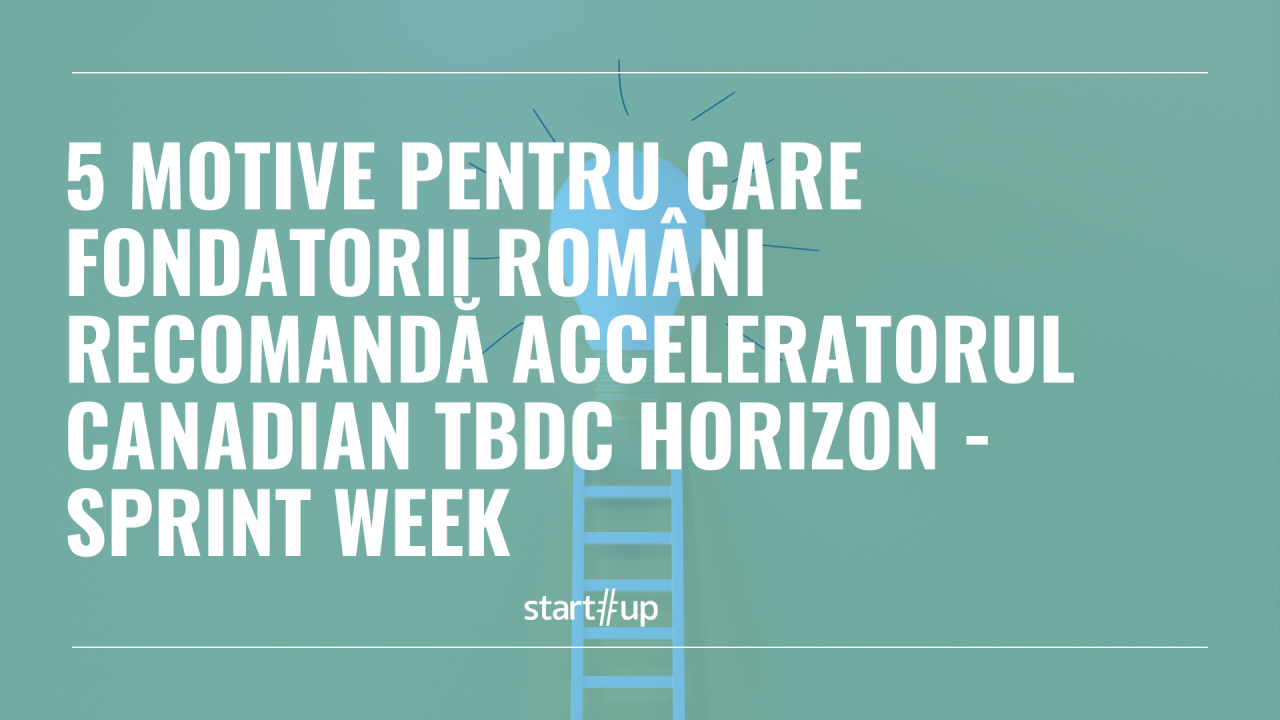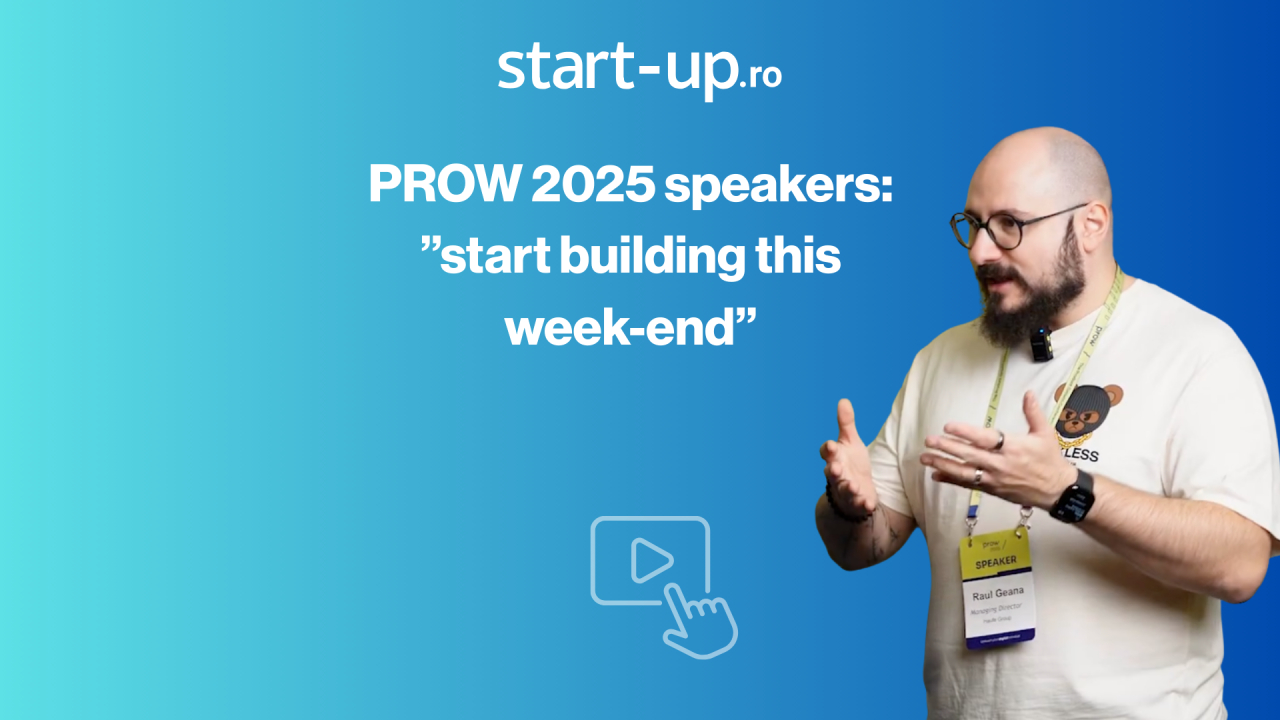PROW is a tech-conference that not only delivers professional advice and information but binds and inspires the tech-community to do better.
The conference reached its 4th edition, 2 days, 22 speakers that will gather on 26-27 October to talk about product, growth and the digital power of companies.
One of the speakers is also Aastha Yadav, senior strategy leader with top-tier consulting background from Bain & Co., now heading global product strategy at Bolt OU, incl. strategies around new products, hyper-growth launch, expansion, optimisation and organisation design.
Aastha is currently establishing and leading a team responsible for shaping the Bolt's long-term direction and identifying new growth & optimization opportunities. Drawing on her extensive experience in management consulting, product & strategy, she advises startups on product strategy, growth and expansion.
 Cinci motive pentru care fondatorii români recomandă acceleratorul canadian TBDC Horizon - Sprint Week
Cinci motive pentru care fondatorii români recomandă acceleratorul canadian TBDC Horizon - Sprint Week
Bolt has over 150 million users in over 45 countries and over 500 cities in Europe and Africa. The company aims to accelerate the transition from personal cars to shared mobility, offering better alternatives for every field of use, including on-demand transport, cars and e-scooters for rent, food and food and non-food delivery. The company is the market leader in Romania, Bolt operating in over 25 cities, expanding and continuous service offering and national coverage.
We had the opportunity to get some insights from her on the topic of: how can technology facilitate sustainable growth and how does BOLT do it? Here are some takeaways from our talk.
What are the main key points in Bolt strategy that made it become one of the fastest-growing tech companies in Europe and Africa?
The answer lies more or less in the DNA and the fundamentals of the company itself.
So first is that we never just see a problem and approach it hastily. What we do, and spend a lot of our time on, is validating those opportunities, making sure that we sharpen the ax before we go and start axing the tree. So being more efficient in understanding the landscape that we are entering.
What are the fundamental factors that drive success or that could be the antilogs, things that could be failure inducing and we do not even realize.
So making sure we understand those aspects, trying to understand what are the external forces and what is the domain level knowledge that we have. How do we combine this external forces, knowledge and domain level knowledge and build some sort of like a nonlinear strategy on top of it instead of just doing something blindly.
So we do make data driven, very strategic decisions.
And that is something the strategy team plays a lot of part in as well, which is wherever we think something is going to be high impact, but could also be high effort or high resource requirement.
Then you want to make sure that there isn't a big sunk cost, because if you do something that requires a lot of resources, and you do all that investment, then the the failure would be way higher. But if it's something very small, that doesn't require as much effort, then you can always try those out, you can experiment those and it has generally low effort and like decent incrementality.
What we do as a strategy team: an idea which could be really good, we spend our time validating those ideas. Second is also that once we validated something doesn't mean we don't revisit it, because we want to keep making sure that we are evolving our business models, we're optimizing, we're being very FRUGAL, which is almost one of our companies operating principles.
FRUGAL - you work smart at the same time when you're working hard. This way, you can save costs and pass on those benefits to your customers or even your partners.
We always revisit ideas, even if we validate something. For the past four or five years, the world hasn't been very stable on factors which we cant control. What you can work around is with the inputs. At the end of the day, strategy is a bet that you're making based on the best knowledge you have available, because we haven't seen the future.
You talk about speed in growing: how can strategy give you the rocket fuel for this type of working?
I think there's two parts of growth in general. When you think about where you want to grow and how do you want to grow. And you have to make sure that the sector that you're trying to embark on has really good addressable market size. If you're working in a small addressable market size, it is going to have its limitations.
So making sure that the segment in itself is big in terms of size has really good growth rate.
Traditional industries would have slower growth rates, but if you are in the industry of AI, you invest something today, I'm sure there's going to be 400 times growth in next year or something.
For a good growth rate there is also the strictness from regulation side, from the intensity that you have in terms of competition, all of these things define how attractive this particular segment is. So you have to look at all these factors, make sure that this is attractive.
Then the part of how do we do it comes in place. If you have a good market size, then you can grow to a big scale.
And the second growth is in terms of operations and execution itself and this has more aspects: building yourself, buying it out or partnering?
Because if you cannot build from the scratch, because it's very technical, then partnership could be a better option.
For example, BOLT is strategically partnering with Starship, which is an autonomous delivery robot. Autonomy and autonomous vehicles in general is a tech invention that takes years and years to develop, is not something that you can just do it by hiring two engineers. So scaling through a partnership.
We also have some markets where we operate in franchise mode and not our own mode. For example, in Georgia, Hungary and Austria are our franchise markets because that is the way we could bypass the regulations or the regulatory restrictions that were there.
And then I think another part of how do you do it is also just be smart, be frugal, get people in action, have that enthusiasm, have that culture that we're operating as one. We are all working in this together and everything.
Numerous other apps tried to tackle this market. Some failed, some spent a huge sum of money and investment in order to grow its market share - what made Bolt different?
Making sure there is a layer of tech because tech enables you to scale faster in a more compounding way, you don't need to add more headcount and you can be more efficient.
Also, we are working in flywheels versus a funnel.
So if you have a funnel, you are most likely adding more capital and users on the top of the funnel, then over the duration of the funnel, they reduce and they come out at the bottom. But that means if you want to increase what comes out from the bottom, you got to keep adding more on the top and that takes a lot of capital and that takes a lot of money.
So in general, what you would rather do is create some sort of a flywheel where basically you have a marketplace. That means if you add more drivers, then you will have customers getting drivers easily and lower prices because there's higher competition. So customers find a good value proposition. And then in that case, more customers join, because they hear about it.
There's a lot of organic flow and they realize it's a good service, it's delivering on its promise. So you have more customers; because there are more customers, more drivers join because there's more and more earnings coming in from the drivers. More drivers joining means customers have even better selection of cars and better timing to get it even cheaper so customers can make more orders within the same thing. And then that makes it a better job for the driver as well. So there's more drivers still at the flywheel.
It's not like you push in a lot of money on the top and like it all keeps leaking through the bucket and then you have to keep putting money, but more like you create flywheels, of course there will be leakages. But at least whatever is coming out at the bottom of the funnel is going in again on the top, along with other things. So it's a circle instead of a straight line where things are falling off from.
Most successful scaling campaigns implemented at Bolt
One of the very interesting thing with scooters, until last year, I don't think we have given as such special targeted discounts to customers. What we did instead was everybody gets the most affordable price without any unlock fee compared to the other players.
And then also one of the things is that because the scooters are physically present in front of our eyes, there is a brand recognition. So the majority of the acquisition for scooters and rides was generally done organically because either when you open the app, you can see scooters and when you just see them on the streets. Not exactly a campaign, but cross pollinating.
If you give people more apps to download, there would be some friction, but if they can find it already, then you can cross pollinate, increase awareness and use your existing customer base as a strength to grow the next vertical.
Every market that you launch in, it just like directly allows you to build awareness of your other products into your main core product. So I think that is definitely one of the one of the very smart things to do.
I think one of the campaigns that I like a little bit: we identified that we had very few female drivers and 7,2% were considering driving as a way of making money. And what we did was we started thinking why do we not have as many female drivers?
So there was a very nice video campaign, in fact, done for this. And what we did was we had some of our women drivers from all the countries like UK, Nigeria, or like, you know, even Estonia, and some some of these countries, come in and talk about what are some of the harsh things that they hear, which makes them feel a little insecure about them being a driver, right?
And it was very interesting because some women received comments like, ”oh, women can't drive, women can't park, women can't do this, and that”. And for them it was about not feeling safe. So what we did was we did a really nice campaign.
And one year later, we did this year over a year after the campaign, and we realized the percentage of our female drivers actually increased significantly since that campaign.
Strategies that looked amazing on paper and in strategy meetings, but failed the market test?
So pandemic happened and ride hailing business stopped. For the months that there was complete complete lockdown, because who are the drivers going to drive? Nobody was going anywhere.
And in general, the business just saw 70 to 80 percent decline across everywhere. So what people started doing was focusing on deliveries, because now everybody needed deliveries.
And one of the things that I think we tried, apart from grocery and food delivery, what we wanted to try was delivery of other things like, I don't know, some other objects.
So if you want to order something within the city, but you cannot go because of lockdowns, then Bolt can help with that delivery. So we launched the service on the business side of the customer. So what it meant was that our end customer was going to be the shop who gets this delivery request.
And they just tell us what they just request for these deliveries from the shop to the address. And then we just go pick up and deliver from the shop to the address. And there would be just the regular delivery fee that we paid to the courier. So overall, everything sounds good. Like, you know, on paper, it should work.
But what we realized after operating it for six months was that it was missing a hard value proposition, about that customer willing to pay for it because in general, because there is no other category than food, grocery or pharma which has the level of urgency of needing it in 30 minutes or two hours. Everything else you're okay receiving tomorrow, day after, maybe in five days, you don't need it now in 30 minutes or one hour.
So unit economics wise, it is really not feasible because if people are not willing to pay any delivery fee, because it's not that urgent, then the model doesn't work. So the strategy kind of failed in the in the sequence where we were validating tif there is even demand. And we shut down the business after one year of operations.
 Irina Achim
Irina Achim














